SUBARU SOLTERRA 2023 Owners Manual
Manufacturer: SUBARU, Model Year: 2023, Model line: SOLTERRA, Model: SUBARU SOLTERRA 2023Pages: 628, PDF Size: 11.91 MB
Page 551 of 628
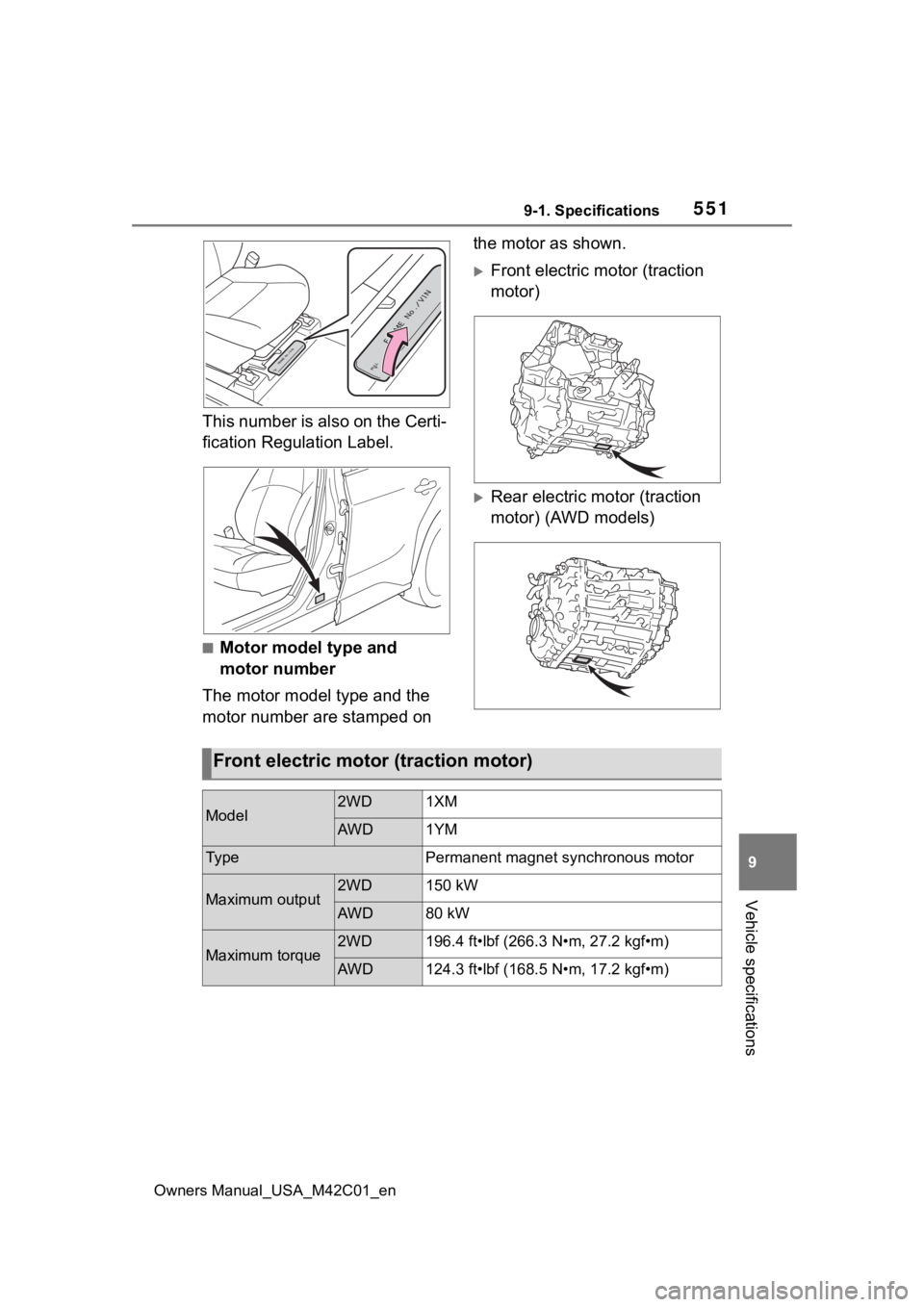
5519-1. Specifications
Owners Manual_USA_M42C01_en
9
Vehicle specifications
This number is also on the Certi-
fication Regulation Label.
■Motor model type and
motor number
The motor model type and the
motor number are stamped on the motor as shown.
Front electric motor (traction
motor)
Rear electric motor (traction
motor) (AWD models)
Front electric mot
or (traction motor)
Model2WD1XM
AWD1YM
Ty p ePermanent magnet synchronous motor
Maximum output2WD150 kW
AWD80 kW
Maximum torque2WD196.4 ft•lbf (266.3 N•m, 27.2 kgf•m)
AWD124.3 ft•lbf (168.5 N•m, 17.2 kgf•m)
Page 552 of 628
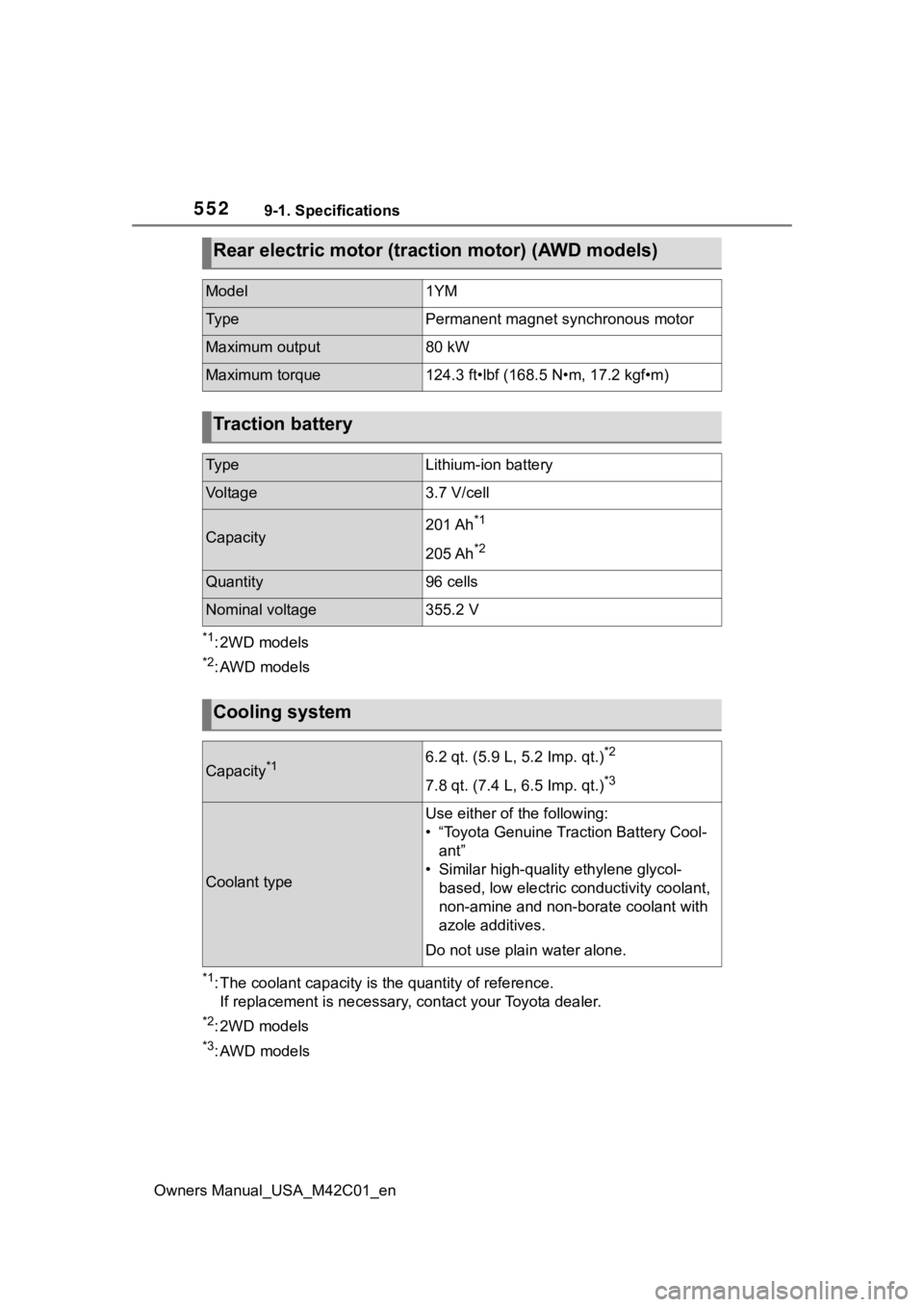
5529-1. Specifications
Owners Manual_USA_M42C01_en
*1: 2WD models
*2: AWD models
*1: The coolant capacity is the quantity of reference.
If replacement is ne cessary, contact your Toyota dealer.
*2: 2WD models
*3: AWD models
Rear electric motor (traction motor) (AWD models)
Model1YM
Ty p ePermanent magnet synchronous motor
Maximum output80 kW
Maximum torque124.3 ft•lbf (168.5 N•m, 17.2 kgf•m)
Traction battery
Ty p eLithium-ion battery
Voltage3.7 V/cell
Capacity201 Ah*1
205 Ah*2
Quantity96 cells
Nominal voltage355.2 V
Cooling system
Capacity*16.2 qt. (5.9 L, 5.2 Imp. qt.)*2
7.8 qt. (7.4 L, 6.5 Imp. qt.)*3
Coolant type
Use either of the following:
• “Toyota Genuine Tra ction Battery Cool-
ant”
• Similar high-quality ethylene glycol- based, low electric conductivity coolant,
non-amine and non-b orate coolant with
azole additives.
Do not use plain water alone.
Page 553 of 628
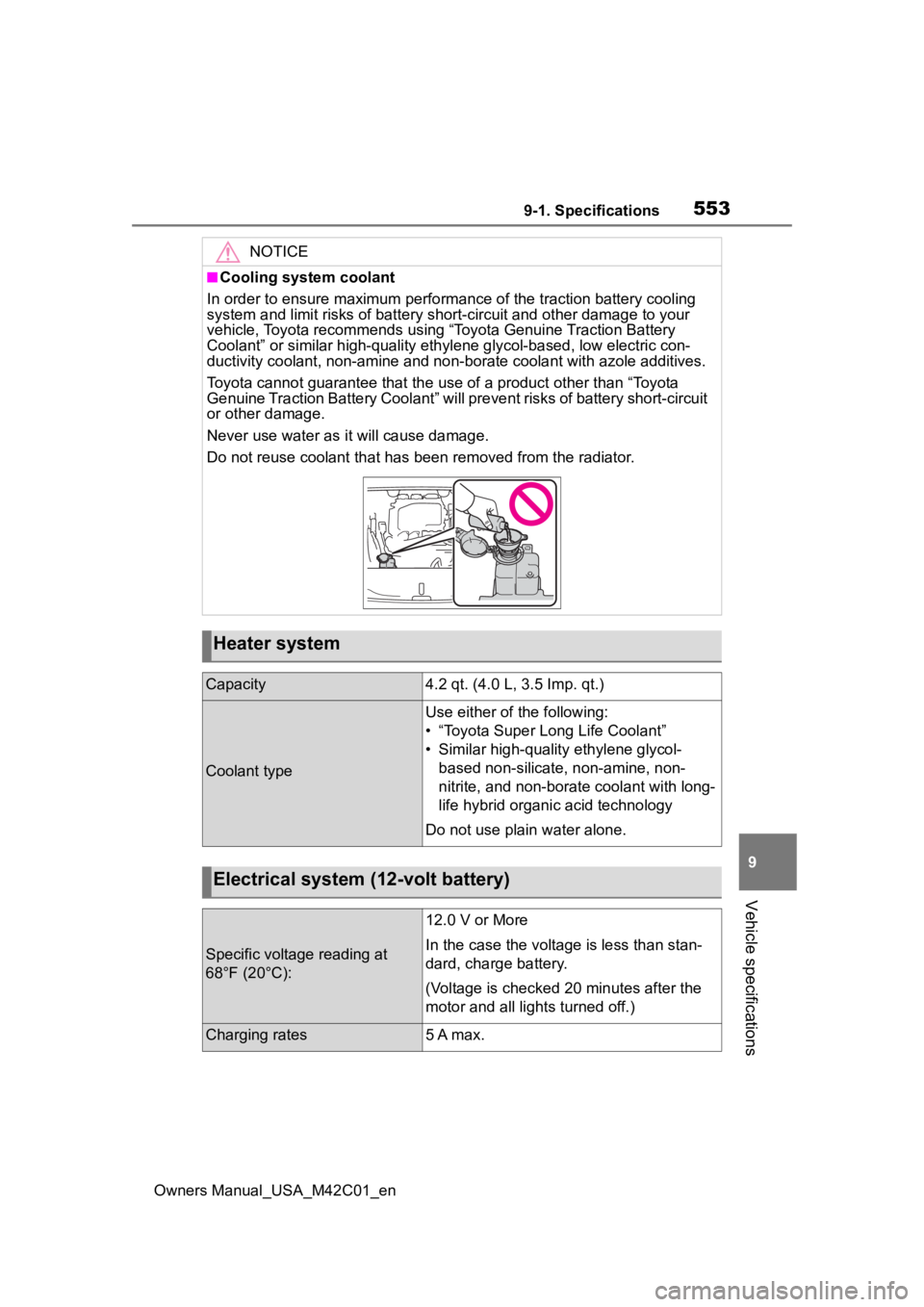
5539-1. Specifications
Owners Manual_USA_M42C01_en
9
Vehicle specifications
NOTICE
■Cooling system coolant
In order to ensure maximum perfor mance of the traction battery cooling
system and limit risks of battery short-circuit and other damag e to your
vehicle, Toyota recommends using “Toyota Genuine Traction Battery
Coolant” or similar high-quality ethylene glycol-based, low electric con-
ductivity coolant, non-amine and non-borate coolant with azole additives.
Toyota cannot guarantee that th e use of a product other than “Toyota
Genuine Traction Battery Cool ant” will prevent risks of battery short-circuit
or other damage.
Never use water as it will cause damage.
Do not reuse coolant that has been removed from the radiator.
Heater system
Capacity4.2 qt. (4.0 L, 3.5 Imp. qt.)
Coolant type
Use either of the following:
• “Toyota Super Long Life Coolant”
• Similar high-quality ethylene glycol- based non-silicate , non-amine, non-
nitrite, and non-borate coolant with long-
life hybrid organic acid technology
Do not use plain water alone.
Electrical system ( 12-volt battery)
Specific voltage reading at
68°F (20°C):
12.0 V or More
In the case the voltage is less than stan-
dard, charge battery.
(Voltage is checked 20 minutes after the
motor and all lights turned off.)
Charging rates5 A max.
Page 554 of 628
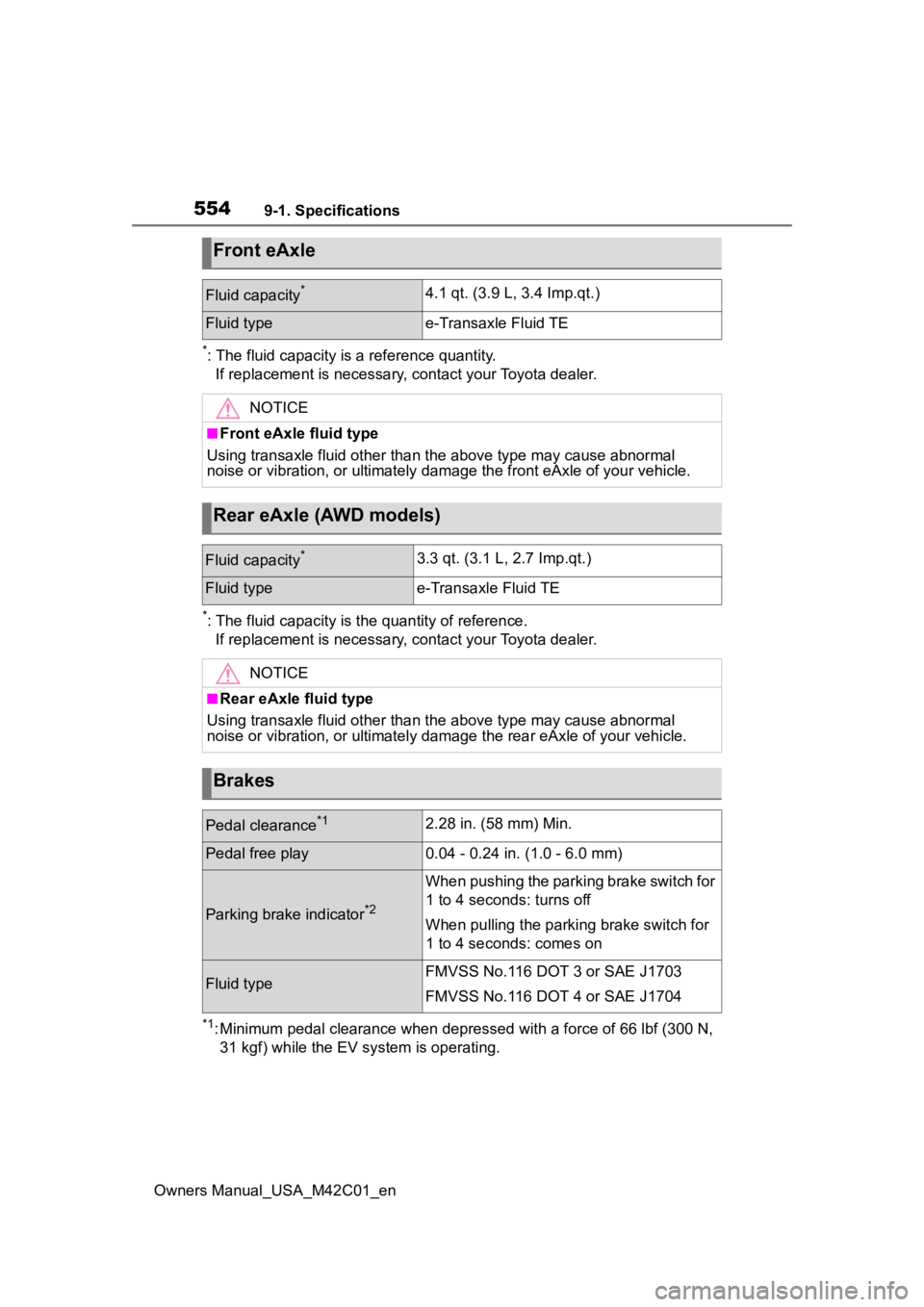
5549-1. Specifications
Owners Manual_USA_M42C01_en
*: The fluid capacity is a reference quantity.If replacement is necessary, contact your Toyota dealer.
*: The fluid capacity is the quantity of reference.If replacement is necessary, contact your Toyota dealer.
*1: Minimum pedal clearance when depressed with a force of 66 lbf (300 N, 31 kgf) while the EV system is operating.
Front eAxle
Fluid capacity*4.1 qt. (3.9 L, 3.4 Imp.qt.)
Fluid typee-Transaxle Fluid TE
NOTICE
■Front eAxle fluid type
Using transaxle fluid other than the above type may cause abnor mal
noise or vibration, or ultimately damage the front eAxle of you r vehicle.
Rear eAxle (AWD models)
Fluid capacity*3.3 qt. (3.1 L, 2.7 Imp.qt.)
Fluid typee-Transaxle Fluid TE
NOTICE
■Rear eAxle fluid type
Using transaxle fluid other than the above type may cause abnor mal
noise or vibration, or ultimatel y damage the rear eAxle of your vehicle.
Brakes
Pedal clearance*12.28 in. (58 mm) Min.
Pedal free play0.04 - 0.24 in. (1.0 - 6.0 mm)
Parking brake indicator*2
When pushing the parking brake switch for
1 to 4 seconds: turns off
When pulling the parking brake switch for
1 to 4 seconds: comes on
Fluid typeFMVSS No.116 DOT 3 or SAE J1703
FMVSS No.116 DOT 4 or SAE J1704
Page 555 of 628
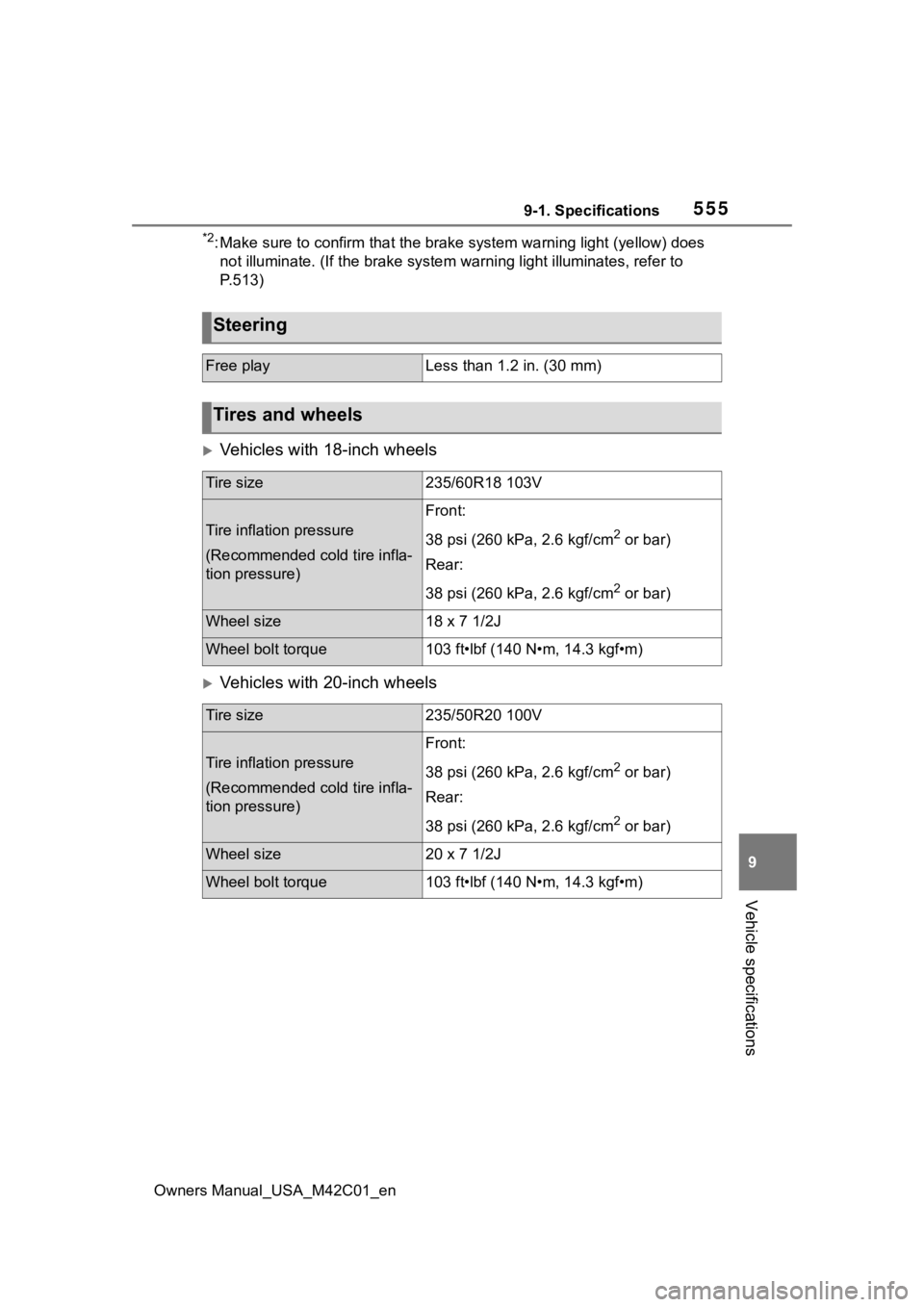
5559-1. Specifications
Owners Manual_USA_M42C01_en
9
Vehicle specifications
*2: Make sure to confirm that the brake system warning light (yell ow) does
not illuminate. (If th e brake system warning light illuminates, refer to
P.513)
Vehicles with 18-inch wheels
Vehicles with 20-inch wheels
Steering
Free playLess than 1.2 in. (30 mm)
Tires and wheels
Tire size235/60R18 103V
Tire inflation pressure
(Recommended cold tire infla-
tion pressure)
Front:
38 psi (260 kPa, 2.6 kgf/cm
2 or bar)
Rear:
38 psi (260 kPa, 2.6 kgf/cm
2 or bar)
Wheel size18 x 7 1/2J
Wheel bolt torque103 ft•lbf (140 N•m, 14.3 kgf•m)
Tire size235/50R20 100V
Tire inflation pressure
(Recommended cold tire infla-
tion pressure)
Front:
38 psi (260 kPa, 2.6 kgf/cm
2 or bar)
Rear:
38 psi (260 kPa, 2.6 kgf/cm
2 or bar)
Wheel size20 x 7 1/2J
Wheel bolt torque103 ft•lbf (140 N•m, 14.3 kgf•m)
Page 556 of 628
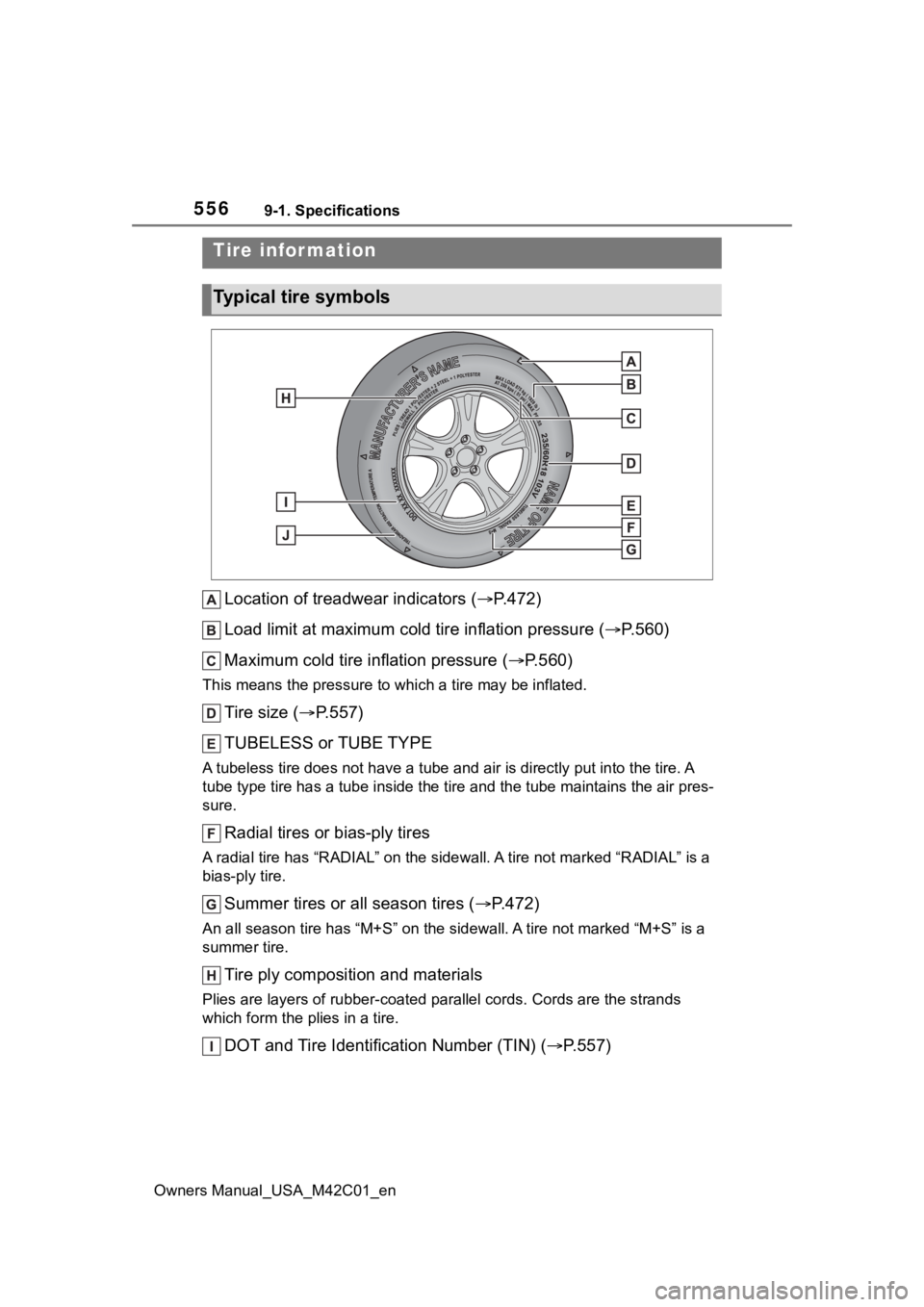
5569-1. Specifications
Owners Manual_USA_M42C01_en
Location of treadwear indicators (P.472)
Load limit at maximum cold tire inflation pressure (P.560)
Maximum cold tire inflation pressure ( P.560)
This means the pressure to w hich a tire may be inflated.
Tire size (P.557)
TUBELESS or TUBE TYPE
A tubeless tire does not have a tube and air is directly put into the tire. A
tube type tire has a tube inside t he tire and the tube maintains the air pres-
sure.
Radial tires or bias-ply tires
A radial tire has “RADIAL” on the sidewall. A tire not marked “ RADIAL” is a
bias-ply tire.
Summer tires or all season tires ( P.472)
An all season tire has “M+S” on the sidewal l. A tire not marked “M+S” is a
summer tire.
Tire ply composition and materials
Plies are layers of rubber-coat ed parallel cords. Cords are the strands
which form the pl ies in a tire.
DOT and Tire Identification Number (TIN) ( P.557)
Tire information
Typical tire symbols
Page 557 of 628
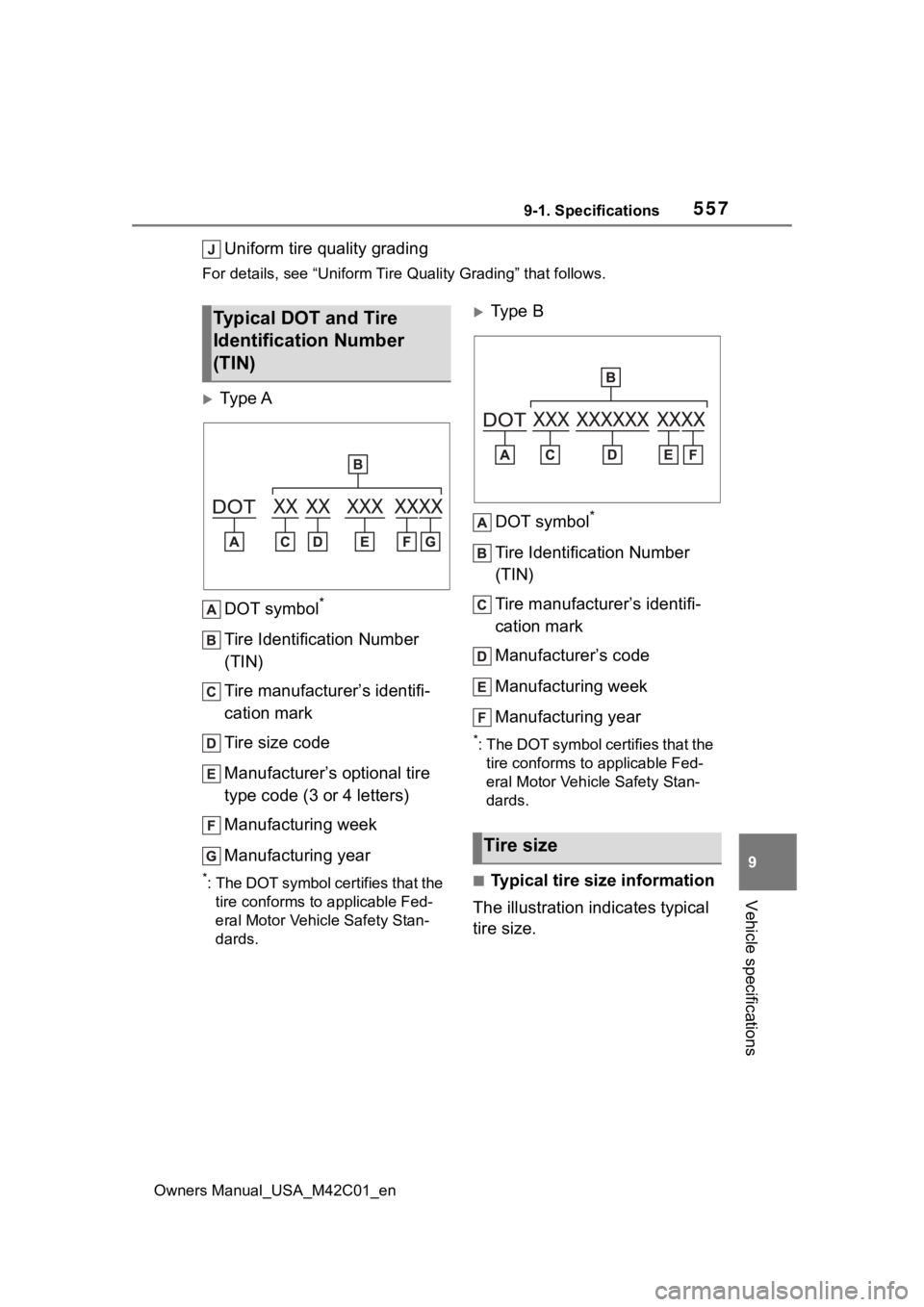
5579-1. Specifications
Owners Manual_USA_M42C01_en
9
Vehicle specifications
Uniform tire quality grading
For details, see “Uniform Tire Quality Grading” that follows.
Ty p e A
DOT symbol
*
Tire Identification Number
(TIN)
Tire manufacturer’s identifi-
cation mark
Tire size code
Manufacturer’s optional tire
type code (3 or 4 letters)
Manufacturing week
Manufacturing year
*: The DOT symbol certifies that the tire conforms to applicable Fed-
eral Motor Vehicle Safety Stan-
dards.
Type B
DOT symbol
*
Tire Identification Number
(TIN)
Tire manufacturer’s identifi-
cation mark
Manufacturer’s code
Manufacturing week
Manufacturing year
*: The DOT symbol ce rtifies that the
tire conforms to applicable Fed-
eral Motor Vehicle Safety Stan-
dards.
■Typical tire size information
The illustration indicates typical
tire size.
Typical DOT and Tire
Identification Number
(TIN)
Tire size
Page 558 of 628
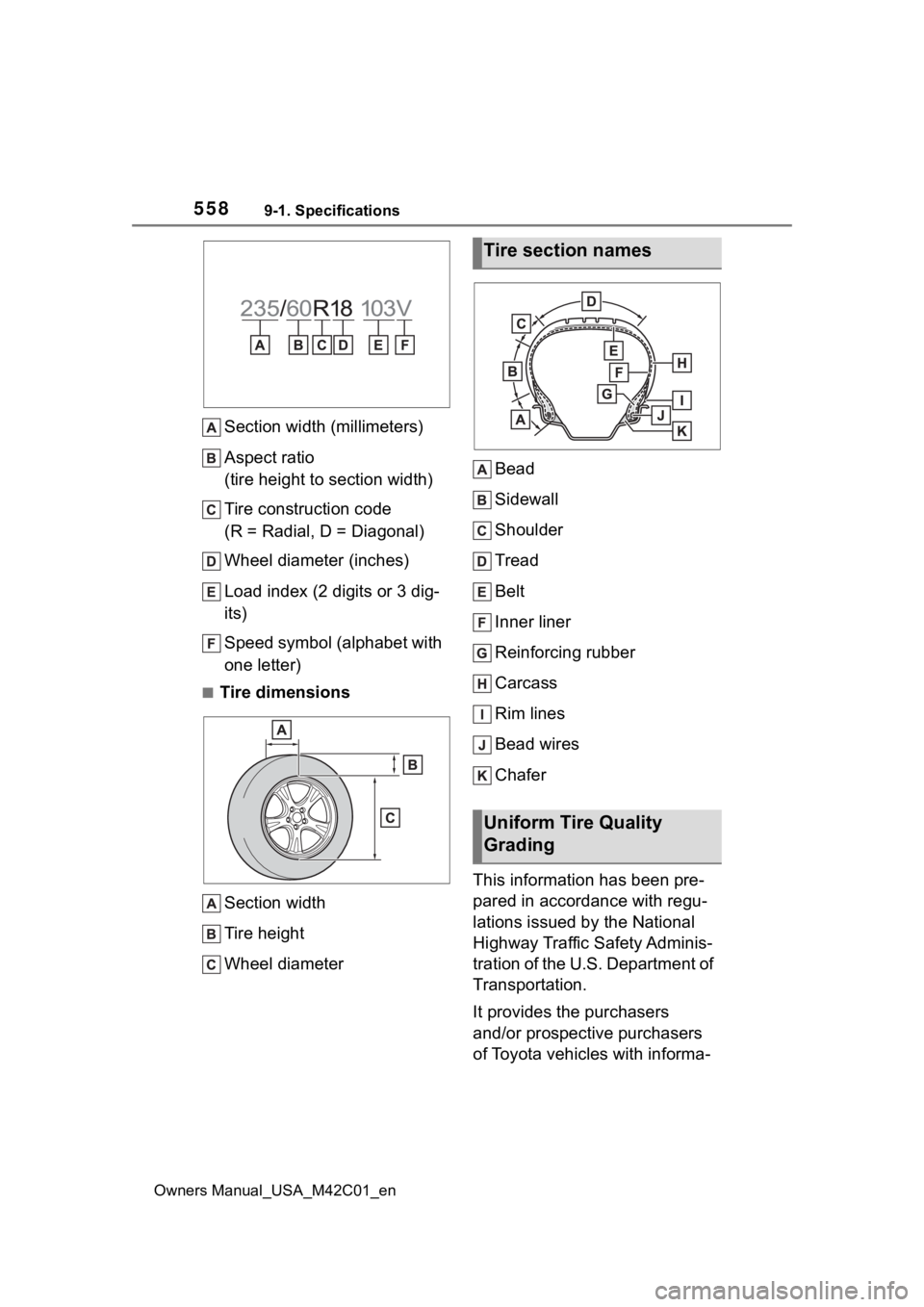
5589-1. Specifications
Owners Manual_USA_M42C01_en
Section width (millimeters)
Aspect ratio
(tire height to section width)
Tire construction code
(R = Radial, D = Diagonal)
Wheel diameter (inches)
Load index (2 digits or 3 dig-
its)
Speed symbol (alphabet with
one letter)
■Tire dimensionsSection width
Tire height
Wheel diameter Bead
Sidewall
Shoulder
Tread
Belt
Inner liner
Reinforcing rubber
Carcass
Rim lines
Bead wires
Chafer
This information has been pre-
pared in accordance with regu-
lations issued by the National
Highway Traffic Safety Adminis-
tration of the U.S. Department of
Transportation.
It provides the purchasers
and/or prospective purchasers
of Toyota vehicles with informa-
Tire section names
Uniform Tire Quality
Grading
Page 559 of 628

5599-1. Specifications
Owners Manual_USA_M42C01_en
9
Vehicle specifications
tion on uniform tire quality grad-
ing.
Your Toyota dealer will help answer
any questions you may have as you
read this information.
■DOT quality grades
All passenger vehicle tires must
conform to Federal Safety
Requirements in addition to
these grades. Quality grades
can be found where applicable
on the tire sidewall between
tread shoulder and maximum
section width.
For example: Treadwear 200 Trac-
tion AA Temperature A
■Treadwear
The treadwear grade is a com-
parative rating based on the
wear rate of the tire when tested
under controlled conditions on a
specified government test
course.
For example, a tire graded 150
would wear one and a half (1 - 1/2)
times as well on the government
course as a tire graded 100.
The relative perfo rmance of tires
depends upon the actual conditions
of their use. Performance may differ
significantly from the norm due to
variations in driving habits, service
practices and differences in road
characteristics and climate.
■Traction AA, A, B, C
The traction grades, from high-
est to lowest, are AA, A, B and
C, and they represent the tire’s
ability to stop on wet pavement as measured under controlled
conditions on specified govern-
ment test surfaces of asphalt
and concrete.
A tire marked C may have poor
traction performance.
Warning: The traction grade
assigned to this tire is based on
braking (straight ahead) traction
tests and does not include corner-
ing (turning) traction.
■Temperature A, B, C
The temperature grades are A
(the highest), B, and C, repre-
senting the tire’s resistance to
the generation of heat and its
ability to dissipate heat when
tested under controlled condi-
tions on a specified indoor labo-
ratory test wheel.
Sustained high temperature can
cause the material of the tire to
degenerate and reduce tire life, and
excessive temperature can lead to
sudden tire failure.
Grade C corresponds to a level of
performance which all passenger
car tires must meet under the Fed-
eral Motor Vehicle Safety Standard
No. 109.
Grades B and A represent higher
levels of performance on the labo-
ratory test wheel than the minimum
required by law.
Warning: The temperature grades
of a tire assume tha t it is properly
inflated and not overloaded.
Excessive speed, underinflation, or
excessive loading, either sepa-
rately or in combination, can cause
Page 560 of 628
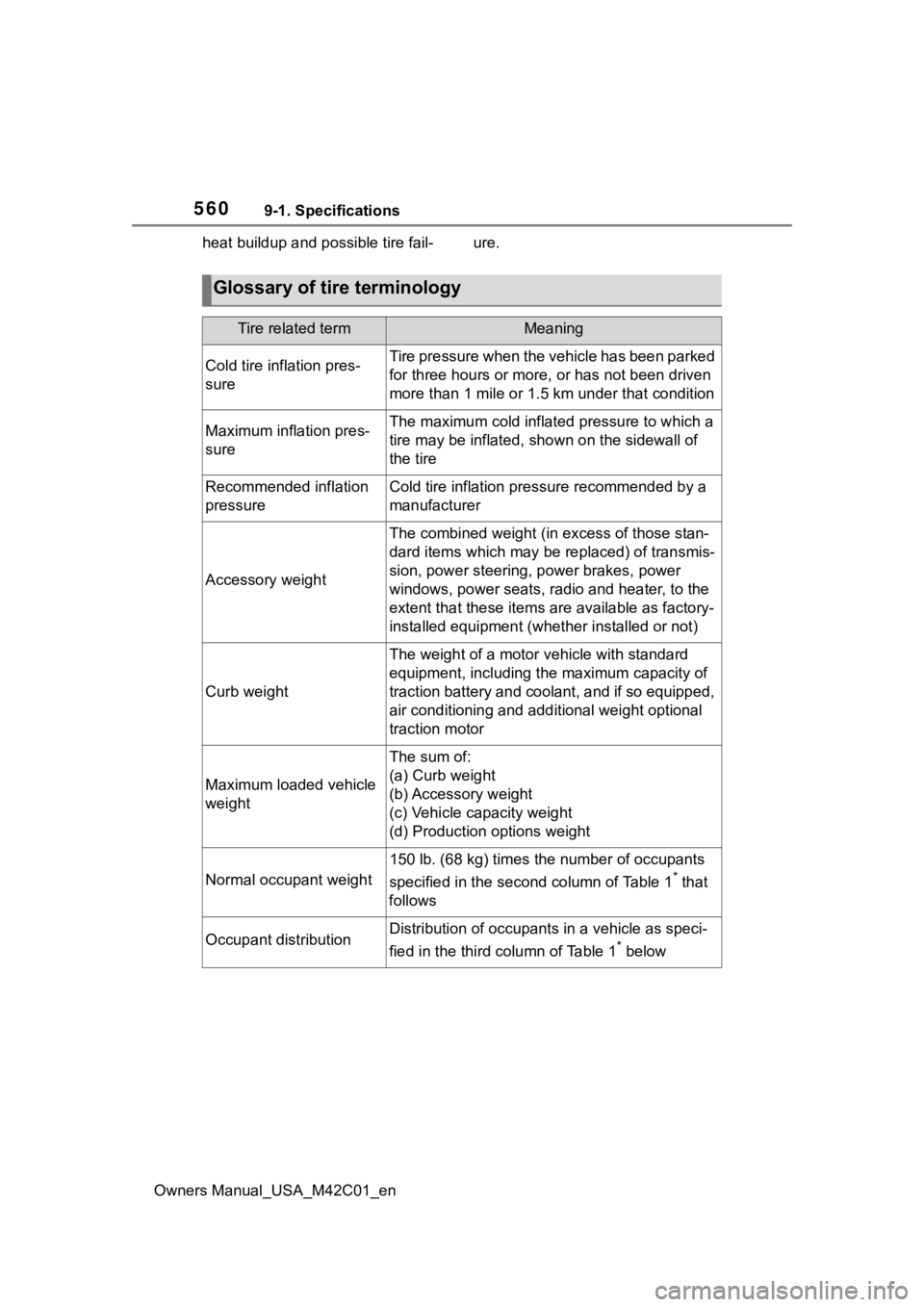
5609-1. Specifications
Owners Manual_USA_M42C01_enheat buildup and possible tire fail- ure.
Glossary of tire terminology
Tire related termMeaning
Cold tire inflation pres-
sureTire pressure when the vehicle has been parked
for three hours or more, or has not been driven
more than 1 mile or 1.5 km under that condition
Maximum inflation pres-
sureThe maximum cold inflated pressure to which a
tire may be inflated, shown on the sidewall of
the tire
Recommended inflation
pressureCold tire inflation pressure recommended by a
manufacturer
Accessory weight
The combined weight (in
excess of those stan-
dard items which may be replaced) of transmis-
sion, power steering, power brakes, power
windows, power seats, radio and heater, to the
extent that these items are available as factory-
installed equipment (whether installed or not)
Curb weight
The weight of a motor vehicle with standard
equipment, including th e maximum capacity of
traction battery and coolant, and if so equipped,
air conditioning and additional weight optional
traction motor
Maximum loaded vehicle
weight
The sum of:
(a) Curb weight
(b) Accessory weight
(c) Vehicle capacity weight
(d) Production options weight
Normal occupant weight
150 lb. (68 kg) times the number of occupants
specified in the second column of Table 1
* that
follows
Occupant distributionDistribution of occupant s in a vehicle as speci-
fied in the third column of Table 1
* below